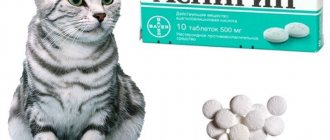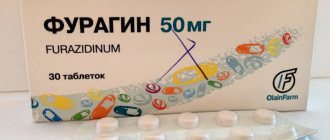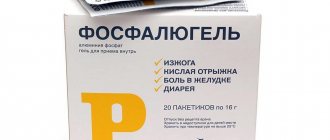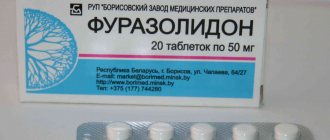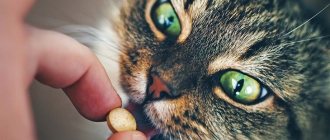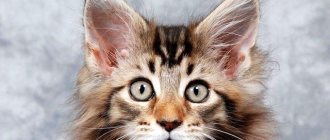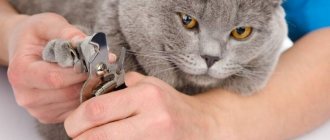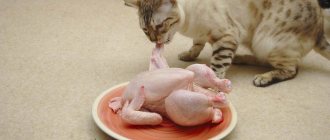Drugs intended for humans are often used in veterinary medicine. One of them is No-Shpa, which can be used to treat animals of any breed.
It helps to effectively relieve spasms and colic. It is used in the form of tablets or injections. The drug provokes adverse reactions extremely rarely.
Description
No-Spa is a popular antispasmodic that can be used alone or in combination with other medications. The drug is widely used in the treatment of domestic animals.
The drug is aimed at reducing muscle tone in the gastrointestinal tract, genitourinary system, biliary tract, promotes dilation of blood vessels and normalizes blood circulation.
Due to its effect on smooth muscles, it helps relieve painful spasms and improve the condition of the animal.
No-shpu is used in the following cases:
- colitis;
- urolithiasis disease;
- renal colic;
- cystitis;
- cholecystitis;
- stomach ulcer;
- constipation;
- complications after surgery;
- increased uterine tone in pregnant animals.
Important! The drug does not affect the functioning of organs, does not accumulate in the kidneys and liver and does not affect the central nervous system.
The drug is available in the form of film-coated tablets or solutions intended for injection.
Overdose
An overdose of No-shpa is still possible. The cat may develop symptoms such as vomiting, nausea, the previously mentioned paresis of the limbs, and foam at the mouth.
What should a caring owner do, especially if he was “lucky” and took his animal to an indifferent veterinarian who does not do his job well?
First of all, urgently call a veterinarian. There are such “animal” doctors who literally pull animals out of the other world.
And if there is a doctor, but you have to wait a long time for him, then you need to force the cat to drink. And then, when the vet comes, immediately put him on a drip.
It is better to avoid an “overdose” and strictly follow all instructions, including instructions regarding dosage.
How and where to inject?
Intramuscularly
Injections are administered intramuscularly.
Also, in some cases, you can inject the drug into the withers, subcutaneously, in the area of the shoulder blades. This is determined by the problem at hand and is resolved by the veterinarian.
Subcutaneously at the withers
It is better to have a specialist give the injection to your four-legged friend. If this is not possible, you should adhere to the following recommendations:
- The injection should only be given into a relaxed muscle, otherwise it will hurt the animal. To do this, you can do a light massage. The paw should be slightly bent.
- There is no need to use a disinfectant. This is only required if there is inflammation.
- You should absolutely not touch the needle with your hands, otherwise you can cause an infection in the muscle.
- The solution used should be neither too cold nor too hot. The body temperature is optimal - then the animal will feel almost nothing.
- There are places on the leg where injections cannot be given. They contain nerve trunks that can cause a lot of unpleasant sensations in the animal.
Attention! It is also important to place the syringe correctly.
There is no need to pre-dilute the solution. It is recommended to use insulin syringes equipped with particularly thin needles.
Intravenously
Intravenous injections are prescribed extremely rarely, as the risk of side effects and complications is high.
When can No-shpa be given, and for what diseases is it prescribed?
Veterinarians usually prescribe No-shpa for cystitis, urolithiasis, urethritis, and kidney diseases. The drug effectively relieves spasms of smooth muscles, which can be a consequence of cholecystitis, papillitis, cholecystolithiasis, cholangitis or pericholecystitis. No-spa eliminates spasms in the bladder muscles caused by pyelitis, cystitis, and nephrolithiasis. Often, this remedy is used for intestinal diseases (colitis, flatulence, constipation) and for peptic ulcers and gastritis of the stomach.
No-Shpu is prescribed for diseases accompanied by severe spasms.
Daily portion by weight
For small breeds
As a rule, tablets are prescribed for individuals weighing over 10 kg; injections are indicated for smaller dogs.
The dosage is 1 ml of solution per 10 kg of weight, no more than two injections are performed in total, respectively, the daily dosage is 1 or 2 ml. But in each individual case it is determined by the doctor individually.
For large
Tablets are recommended for large dogs. A maximum of two are prescribed at the rate of one tablet (40 mg of active substance) per 10 kg of weight. If necessary, the maximum dosage is 80 mg of the main substance or 2 ml if we are talking about injections.
How many times?
No-shpu, both in the form of tablets and in the form of injections, cannot be used on dogs more than twice a day.
How many days?
A single dose may be sufficient to relieve symptoms. If longer-term treatment is necessary, the medication can be used for several days or even months. The exact course of treatment should be determined by the doctor in each specific case.
Instructions for use and dosage
First of all, we need to touch on the topic of correct dosage. This matter is very important and responsible, so they should not do it themselves (selecting the dosage), but entrust this matter to a specialist, a veterinarian.
The proposed replacement of this drug with “Papaverine” whenever possible is not accidental, because many cat lovers testify to such a side effect as paresis (paralysis!) of the limbs.
It must be said that most clinics that specialize in the treatment of animals do not want to change themselves and their long-established rules and still practice the use of the antispasmodic “No-shpa”. The dosage for cats usually does not exceed 0.2 mg per kilogram of weight. More often, the attending veterinarian limits himself to even 0.1 ml of the medicine.
The veterinarian usually prescribes this medication to be given twice daily. Calculation of the correct dosage of tablets occurs in the same way: 0.1 mg of the drug per kg of the cat’s weight.
Since the tablets have a bitter taste, in order for the animal to swallow the tablet, it can be ground into powder or wrapped in bread crumb.
You can even dilute it in a fairly large amount of water and feed the animal with it throughout the day.
Important!
But despite the fact that it seems that giving tablets to an animal is more convenient for the owner, in general the use of tablets is less effective, since administering the drug by mouth often causes vomiting, nausea and similar “charms”.
Often animals simply spit out the pills.
If it gets bad
The drug has a minimum of contraindications and can be prescribed to animals of different ages and conditions.
Side effects are extremely rare. However, in some cases the following phenomena are possible:
- arrhythmia;
- a sharp decrease in pressure;
- depression of the respiratory center.
In the most severe cases, collapses were noted. Side effects mainly occur when the drug is administered intravenously, so such injections are practically not used.
Although the drug has low toxicity, it can be dangerous for dogs.
An overdose of the drug can cause nausea and vomiting, depression, loss of appetite or short-term convulsions. In this case, specific treatment is not required - usually the symptoms go away on their own after 1-2 days.
In some cases, an allergic reaction is possible. If its signs are noted, the drug is stopped. To mitigate the effect of the medication, anticholinergics can be used. They are indicated in the treatment of stomach or duodenal ulcers.
Composition and action
Tablet No-shpa contains the active ingredient drotaverine in a dosage of 40 mg. It has a high absorption rate through the gastric mucosa and quickly enters the bloodstream. The concentration of the active substance in the blood plasma reaches its maximum within an hour after taking No-shpa.
The active substance drotaverine inhibits the phosphodiesterase enzyme, resulting in relaxation of the smooth muscles of the digestive tract, genitourinary system, bile and urinary tract. Spasms are relieved and the pain caused by them is eliminated.
How to give an injection to a cat?
The medicine is usually prescribed by injection, this causes indignation among many owners (i.e. nominal owners) of furry and not so furry creatures.
In their opinion, No-shpa injections can cause irreversible consequences, including paralysis of the hind legs. It can be partial or complete. But both of these disorders are not much better.
It is possible that individual allergic or even nervous system reactions to taking the medication by injection may occur.
The disadvantage of this form of the drug: No-shpa injections are extremely painful, they can even cause a state of shock from pain. Therefore, it is very important to follow the dosage prescribed by your veterinarian.
Attention!
To reduce the animal’s negative reactions to a minimum or practically to zero, injections must be administered very slowly and as deeply as possible intramuscularly.
A number of veterinarians advise using medicine in tablets instead of injections. Everything here is not as simple as it seems at first glance. The tablet has a drawback - it has a very bitter taste, therefore it is not easy to get the cat to swallow it. There are some tricks, but they will be discussed later.
No-spa is a stronger medicine against spasms, its effect is quite long-lasting. Therefore, if a specialist recommends using it, then there are extremely compelling reasons for this.
No-Shpu is used if there are diseases of the so-called biliary tract, as well as accompanying spasms of smooth muscles (for example, papillitis, cholecystitis). No-spa also helps with spasms of the genitourinary system (otherwise called cystitis) and with ulcers and flatulence in the gastrointestinal tract.
First of all, your hands must be clean, the syringe must be sterile, this means that under no circumstances should you touch the syringe with anything. Particularly with your hands. If the ampoule has been previously opened, then under no circumstances should the drug be given to a cat from it.
Reference!
Some bottles must be shaken before use. Therefore, you need to pay attention to whether this needs to be done in relation to the no-shpa.
- Open the ampoule with a special file or wrap it in cotton wool, and break off the top, pointing the ampoule away from you.
- In the main part of modern ampoules there is a special ring or circle that serves as an indicator. If you press the tip of the ampoule in the opposite direction from the indicator circle, the ampoule will open without any force or special filing. In a number of domestic ampoules, these mugs do not have any functions, and serve only for beauty; you still have to do filing.
- Then you need to insert the needle into the ampoule and slowly (this is important!) take out the required amount of medicine, in this case - “No-shpa”.
- Then, put the ampoule aside for a while and place the syringe in your hand with the needle up, “give a few clicks or even clicks” on the syringe and, pressing on the piston, expel the trapped air and excess drug from the syringe.
- Now comes the most important and interesting part: the introduction.
- Next, you need to strictly follow the doctor’s recommendations or the instructions for No-shpe. It’s better to be guided by both.
Where to inject no-shpu?
Many owners ask this question, but there is no way to do it without consulting a veterinarian. Usually the drugs, and this one too, hit the withers.
What are the withers of kitties? This is the same as the colloquial word “scratch”. That is, the place where the neck ends and the back begins. The withers are easy to find at the point between the shoulder blades. It is extremely easy to palpate.
You can find the withers even easier: Grasp the base of the front paws with one hand and move your hand up, gradually squeezing it until a thick fold of skin is in your fist. To check, press the hand with the captured skin against the cat’s body - you want the owner to feel the hard bulges of the shoulder blades under it.
An overdose of No-shpa is still possible. The cat may develop symptoms such as vomiting, nausea, the previously mentioned paresis of the limbs, and foam at the mouth.
What should a caring owner do, especially if he was “lucky” and took his animal to an indifferent veterinarian who does not do his job well?
First of all, urgently call a veterinarian. There are such “animal” doctors who literally pull animals out of the other world.
And if there is a doctor, but you have to wait a long time for him, then you need to force the cat to drink. And then, when the vet comes, immediately put him on a drip.
It is better to avoid an “overdose” and strictly follow all instructions, including instructions regarding dosage.
